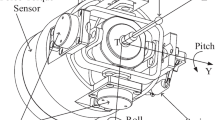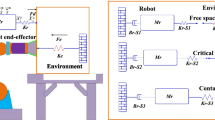Abstract
In robotic polishing applications, the rotating polisher will generate strong vibration disturbance, which makes it more difficult to detect and control the contact force. This paper proposes a novel and practical method to detect and control the contact force using the built-in sensors (motor encoders and joint torque sensors) for actual robotic polishing in harsh conditions of strong vibration disturbance. An extended state observer based on the robot dynamic model is developed to estimate the contact force in real time, and a new and efficient adaptive filter combining insights of the notch filter with the tracking differentiator is designed to relieve the strong vibration disturbance of torque signals from the eccentrically rotating polisher. On the basis of efficient force detection, a hybrid position/force control method based on the inner joint torque controller is proposed to realize accurate force control in actual robotic polishing of curved surfaces. With the proposed contact force detection and control methodology, the robot is potential to achieve satisfied polishing applications in which some usual accessories, such as the six-axis force/torque sensor or Remote Center Compliance device are absent. Experimental results confirm the effectiveness and accuracy of the proposed contact force detection method in conditions of strong vibration disturbance from the rotating polisher. In addition, the curved surface polishing experiments indicate that the new hybrid position/force control framework performs well on rejecting the strong disturbances while maintaining high force control accuracy of polishing, and the quality of polished surface is greatly improved.











Similar content being viewed by others
References
Martínez SS, Ortega JG, García JG, García AS, Estévez EE (2013) An industrial vision system for surface quality inspection of transparent parts. Int J Adv Manuf Technol 68:1123–1136. https://doi.org/10.1007/s00170-013-4904-2
Solanes JE, Gracia L, Muñoz-Benavent P, Miro JV, Perez-Vidal C, Tornero J (2019) Robust hybrid position-force control for robotic surface polishing. J Manuf Sci Eng 141:011013. https://doi.org/10.1115/1.4041836
Wang G, Yu Q, Ren T, Hua X, Chen K (2018) Task planning for mobile painting manipulators based on manipulating space. Assem Autom. https://doi.org/10.1108/AA-04-2017-044
Tsai MJ, Huang JF (2006) Efficient automatic polishing process with a new compliant abrasive tool. Int J Adv Manuf Technol 30:817–827. https://doi.org/10.1007/s00170-005-0126-6
Hu L, Zhan J (2015) Study on the orthomogonalization for hybrid motion/force control and its application in aspheric surface polishing. Int J Adv Manuf Technol 77:1259–1268. https://doi.org/10.1007/s00170-014-6499-7
Huang T, Li C, Wang Z, Sun L, Chen G (2016) Design of a flexible polishing force control flange. In: 2016 IEEE workshop on advanced robotics and its social impacts (ARSO). Pp 91–95
Solanes JE, Gracia L, Muñoz-Benavent P, Esparza A, Valls Miro J, Tornero J (2018) Adaptive robust control and admittance control for contact-driven robotic surface conditioning. Robot Comput Integr Manuf 54:115–132
Whitney DE, Rourke JM (1986) Mechanical behavior and design equations for elastomer shear pad remote center compliances. J Dyn Sys Meas Control 108:223–232. https://doi.org/10.1115/1.3143771
Huang H, Gong ZM, Chen XQ, Zhou L (2002) Robotic grinding and polishing for turbine-vane overhaul. J Mater Process Technol 127:140–145. https://doi.org/10.1016/S0924-0136(02)00114-0
Giublin B, Vieira JA, Vieira TG, Trabasso LG, Martins CA (2014) Experimental analysis of the automated process of sanding aircraft surfaces. Aeronaut J 118:53–64. https://doi.org/10.1017/S0001924000008927
Chen F, Zhao H, Li D, Chen L, Tan C, Ding H (2019) Contact force control and vibration suppression in robotic polishing with a smart end effector. Robot Comput Integr Manuf 57:391–403
Zeng G, Hemami A (1997) An overview of robot force control. Robotica 15:473–482
Navvabi H, Markazi AHD (2019) Hybrid position/force control of Stewart manipulator using extended adaptive fuzzy sliding mode controller (E-AFSMC). ISA Trans 88:280–295. https://doi.org/10.1016/j.isatra.2018.11.037
Hogan N (1984) Impedance control: an approach to manipulation. In: 1984 American control conference. IEEE, pp 304–313
Mason MT (1979) Compliance and force control for computer controlled manipulators MIT Artificial Intelligence Laboratory Memo 515
Raibert MH, Craig JJ (1981) Hybrid position/force control of manipulators. J Dyn Syst Meas Control 103:126. https://doi.org/10.1115/1.3139652
Dai H, Yuen KM, Elbestawi MA (1993) Parametric modelling and control of the robotic grinding process. Int J Adv Manuf Technol 8:182–192. https://doi.org/10.1007/BF01749909
Minami M, Asakura T, Dong LX, Huang YM (1996) Position control and explicit force control of constrained motions of a manipulator for accurate grinding tasks. Adv Robot 11:285–300. https://doi.org/10.1163/156855397X00254
Thomessen T, Lien TK, Sannæs PK (2001) Robot control system for grinding of large hydro power turbines. Ind Robot Int J 28:328–334. https://doi.org/10.1108/01439910110397183
Pan Z, Zhang H (2008) Robotic machining from programming to process control. In: 2008 7th world congress on intelligent control and automation. Pp 553–558
Pan Z, Zhang H (2008) Robotic machining from programming to process control: a complete solution by force control. Ind Robot Int J 35:400–409. https://doi.org/10.1108/01439910810893572
Tian F, Li Z, Lv C, Liu G (2016) Polishing pressure investigations of robot automatic polishing on curved surfaces. Int J Adv Manuf Technol 87:639–646. https://doi.org/10.1007/s00170-016-8527-2
Tian F, Lv C, Li Z, Liu G (2016) Modeling and control of robotic automatic polishing for curved surfaces. CIRP J Manuf Sci Technol 14:55–64. https://doi.org/10.1016/j.cirpj.2016.05.010
Zhang J, Liu G, Zang X, Li L (2016) A hybrid passive/active force control scheme for robotic belt grinding system. In: 2016 IEEE international conference on mechatronics and automation. Pp 737–742
Luh J, Fisher W, Paul R (1983) Joint torque control by a direct feedback for industrial robots. IEEE Trans Autom Control 28:153–161
Wu C (1985) Compliance control of a robot manipulator based on joint torque servo. Int J Robot Res 4:55–71
Hirzinger G, Albu-Schaffer A, Hahnle M, Schaefer I, Sporer N (2001) On a new generation of torque controlled light-weight robots. In: proceedings 2001 ICRA. IEEE international conference on robotics and automation (cat. No.01CH37164). IEEE, pp 3356–3363
Albu-Schaffer A, Eiberger O, Grebenstein M, Haddadin S, Ott C, Wimbock T, Wolf S, Hirzinger G (2008) Soft robotics. IEEE Robot Autom Mag 15:20–30
Ren T, Dong Y, Wu D, Wang G, Chen K (2017) Joint torque control of a collaborative robot based on active disturbance rejection with the consideration of actuator delay. In: ASME 2017 international mechanical engineering congress and exposition. American Society of Mechanical Engineers, p V04AT05A010
Albu-Schäffer A, Hirzinger G (2001) A globally stable state feedback controller for flexible joint robots. Adv Robot 15:799–814
Ott C, Albu-Schaffer A, Kugi A, Stamigioli S, Hirzinger G (2004) A passivity based Cartesian impedance controller for flexible joint robots - part I: torque feedback and gravity compensation. In: IEEE international conference on robotics and automation, 2004. Proceedings. ICRA ‘04. 2004. IEEE, pp 2659–2665
Albu-Schaffer A, Ott C, Hirzinger G (2004) A passivity based Cartesian impedance controller for flexible joint robots - part II: full state feedback, impedance design and experiments. In: IEEE international conference on robotics and automation, 2004. Proceedings. ICRA’04. 2004. IEEE, pp 2666–2672
Englsberger J, Werner A, Ott C, Henze B, Roa MA, Garofalo G, Burger R, Beyer A, Eiberger O, Schmid K, Albu-Schäffer A (2014) Overview of the torque-controlled humanoid robot TORO. In: 2014 IEEE-RAS international conference on humanoid robots. IEEE, pp 916–923
Hur SM, Kim SK, Oh Y, Oh SR (2012) Joint torque servo of a high friction robot manipulator based on time-delay control with feed-forward friction compensation. In: 2012 IEEE RO-MAN: The 21st IEEE International Symposium on Robot and Human Interactive Communication. IEEE, pp 37–42
Ren T, Dong Y, Wu D, Chen K (2019) Impedance control of collaborative robots based on joint torque servo with active disturbance rejection. Ind Robot Int J Robot Res Appl 46:518–528. https://doi.org/10.1108/IR-06-2018-0130
Han J (2009) From PID to active disturbance rejection control. IEEE Trans Ind Electron 56:900–906. https://doi.org/10.1109/TIE.2008.2011621
Dong Y, Ren T, Chen K, Wu D (2018) An efficient robot payload identification method for industrial application. Ind Rob Int J Robot Res Appl 45:505–515. https://doi.org/10.1108/IR-03-2018-0037
Albu-Schaffer A, Hirzinger G (2001) Parameter identification and passivity based joint control for a 7 DOF torque controlled light weight robot. IEEE, pp 2852–2858
Ren T, Dong Y, Wu D, Chen K (2018) Collision detection and identification for robot manipulators based on extended state observer. Control Eng Pract 79:144–153. https://doi.org/10.1016/j.conengprac.2018.07.004
Yoo D, Yau SS-T, Gao Z (2007) Optimal fast tracking observer bandwidth of the linear extended state observer. Int J Control 80:102–111
Zhou W, Shao S, Gao Z (2009) A stability study of the active disturbance rejection control problem by a singular perturbation approach. Appl Math Sci 3:491–508
Luca AD, Mattone R (2003) Actuator failure detection and isolation using generalized momenta. In: 2003 IEEE international conference on robotics and automation (cat. No.03CH37422). Pp 634–639 vol.1
Author information
Authors and Affiliations
Corresponding author
Additional information
Publisher’s note
Springer Nature remains neutral with regard to jurisdictional claims in published maps and institutional affiliations.
Rights and permissions
About this article
Cite this article
Dong, Y., Ren, T., Hu, K. et al. Contact force detection and control for robotic polishing based on joint torque sensors. Int J Adv Manuf Technol 107, 2745–2756 (2020). https://doi.org/10.1007/s00170-020-05162-8
Received:
Accepted:
Published:
Issue Date:
DOI: https://doi.org/10.1007/s00170-020-05162-8




